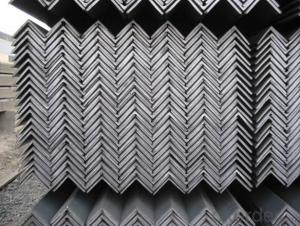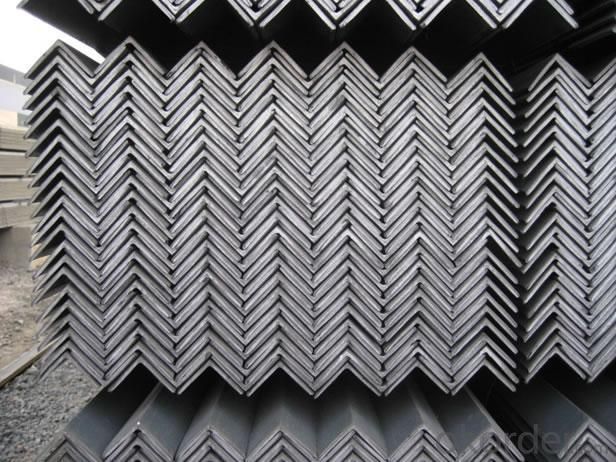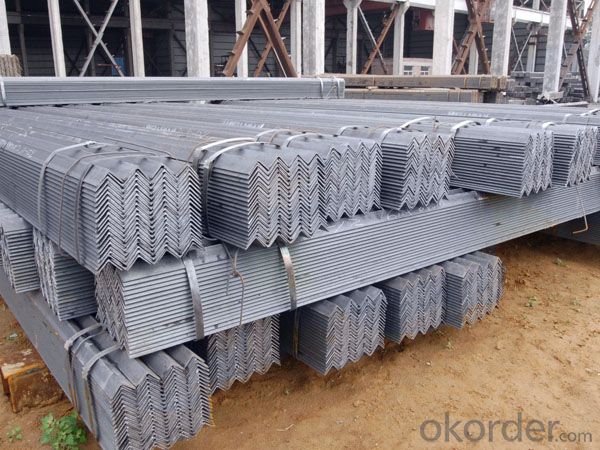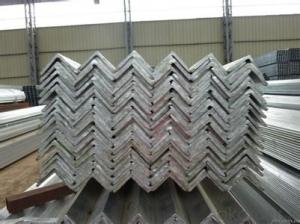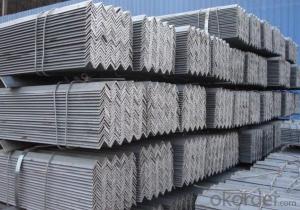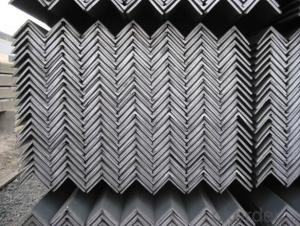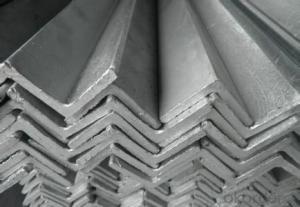high quality angle steel 20-250mm ASTM A36
- Loading Port:
- Shanghai
- Payment Terms:
- TT OR LC
- Min Order Qty:
- 25 m.t.
- Supply Capability:
- 20000 m.t./month
OKorder Service Pledge
OKorder Financial Service
You Might Also Like
Angle steel Details:
| Minimum Order Quantity: | Unit: | m.t | Loading Port: | ||
| Supply Ability: | Payment Terms: | Package: | bundle |
Product Description:
Product Description:
Specifications of Angle Steel
1. Invoicing on theoretical weight or actual weight as customer request
2. Length: 6m, 9m, 12m as following table
3. Sizes
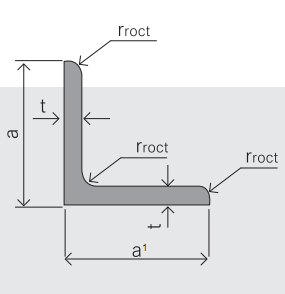
Sizes: 25mm-250mm | ||
a*t | ||
25*2.5-4.0 | 70*6.0-9.0 | 130*9.0-15 |
30*2.5-6.6 | 75*6.0-9.0 | 140*10-14 |
36*3.0-5.0 | 80*5.0-10 | 150*10-20 |
38*2.3-6.0 | 90*7.0-10 | 160*10-16 |
40*3.0-5.0 | 100*6.0-12 | 175*12-15 |
45*4.0-6.0 | 110*8.0-10 | 180*12-18 |
50*4.0-6.0 | 120*6.0-15 | 200*14-25 |
60*4.0-8.0 | 125*8.0-14 | 250*25 |
5. Payment terms:
1).100% irrevocable L/C at sight.
2).30% T/T prepaid and the balance against the copy of B/L.
3).30% T/T prepaid and the balance against L/C
6.Material details:
Alloy No | Grade | Element (%) | |||||
C | Mn | S | P | Si | |||
|
|
|
|
|
|
| |
Q235 | B | 0.12—0.20 | 0.3—0.7 | ≤0.045 | ≤0.045 | ≤0.3 | |
|
|
|
|
|
|
| |
Alloy No | Grade | Yielding strength point( Mpa) | |||||
Thickness (mm) | |||||||
≤16 | >16--40 | >40--60 | >60--100 | ||||
≥ | |||||||
|
|
|
|
|
| ||
Q235 | B | 235 | 225 | 215 | 205 | ||
Alloy No | Grade | Tensile strength (Mpa) | Elongation after fracture (%) | ||||
Thickness (mm) | |||||||
| ≤16 | >16--40 | >40--60 | >60--100 | |||
≥ | |||||||
|
|
|
|
|
|
| |
Q235 | B | 375--500 | 26 | 25 | 24 | 23 | |
Usage & Applications of Angle Steel
According to the needs of different structures, Angle can compose to different force support component, and also can be the connections between components. It is widely used in various building structures and engineering structures such as roof beams, bridges, transmission towers, hoisting machinery and transport machinery, ships, industrial furnaces, reaction tower, container frame and warehouse etc.
Packaging & Delivery of Angle Steel
1. Packing: it is nude packed in bundles by steel wire rod
2. Bundle weight: not more than 3.5MT for bulk vessel; less than 3 MT for container load
3. Marks:
Color marking: There will be color marking on both end of the bundle for the cargo delivered by bulk vessel. That makes it easily to distinguish at the destination port.
Tag mark: there will be tag mark tied up on the bundles. The information usually including supplier logo and name, product name, made in China, shipping marks and other information request by the customer.
If loading by container the marking is not needed, but we will prepare it as customer request.
Production flow of Angle Steel
Material prepare (billet) —heat up—rough rolling—precision rolling—cooling—packing—storage and transportation
- Q: How do you calculate the shear capacity of a steel angle?
- To calculate the shear capacity of a steel angle, you need to consider the following factors: 1. Material properties: Determine the yield strength of the steel angle. This value represents the maximum stress the material can withstand before it starts to deform permanently. 2. Cross-sectional area: Measure the cross-sectional area of the steel angle. This involves calculating the width and thickness of the angle and multiplying them together. 3. Shear stress: Calculate the shear stress applied to the angle by dividing the applied force by the cross-sectional area. 4. Shear capacity: Compare the calculated shear stress to the yield strength of the steel angle. If the shear stress is lower than the yield strength, the angle is safe and can withstand the applied force. However, if the shear stress exceeds the yield strength, the angle may fail and deform. It is important to note that different design codes and standards may have specific equations or factors to consider when calculating the shear capacity of a steel angle. Consulting the relevant design code or seeking assistance from a structural engineer is recommended to ensure accurate and safe calculations.
- Q: Can iron angle steel be welded with stainless steel angle steel?
- If the angle, in a cross-sectional angle welding of carbon steel plate, stainless steel angle welding a stainless steel cross sectional iron. Two cross cutting iron plate punching, 8.8 high strength screw fastening piece.Carbon steel and stainless steel welding, belong to dissimilar metal welding. Higher requirements for welding technology. Screw connections are the most economical,
- Q: Can steel angles be used in high-temperature applications?
- Depending on the alloy and temperature range, steel angles can be utilized in high-temperature scenarios. Stainless steels and heat-resistant alloys, which are specifically engineered for high-temperature applications, possess the ability to endure elevated temperatures without compromising strength or structural integrity. These alloys typically contain elements such as chromium, nickel, or molybdenum, which enhance resistance against corrosion, oxidation, and high temperatures. Nonetheless, it is imperative to acknowledge that not all steel angles are appropriate for high-temperature uses. Ordinary carbon steels, for instance, have a restricted temperature range before experiencing strength loss and becoming vulnerable to deformation or failure. The precise temperature threshold for a specific steel angle relies on factors such as alloy composition, heat treatment, and duration of exposure to high temperatures. To recap, steel angles can be employed in high-temperature applications if they are constructed from suitable alloys specifically designed for such conditions. It is essential to consult materials engineers or experts who can provide guidance on appropriate steel alloys and temperature limits for a given application to ensure performance that is safe and reliable.
- Q: Can steel angles be used for HVAC ductwork?
- Indeed, HVAC ductwork can utilize steel angles. In the construction field, steel angles are frequently employed for diverse purposes, such as acting as supports and reinforcements. In terms of HVAC ductwork, steel angles can serve as a framework, ensuring stability and bolstering the ducts. Through welding or bolting, they can be joined together to create a robust and enduring structure for the ductwork system. Moreover, steel angles can be easily tailored and cut to specific lengths, making them suitable for various configurations of ductwork. Nevertheless, it is crucial to bear in mind that appropriate insulation and lining might be necessary for steel angles to prevent condensation and maintain the desired temperature within the ducts.
- Q: Can steel angles be used in the construction of pipe racks?
- Yes, steel angles can be used in the construction of pipe racks. Steel angles provide structural support and can be used as framing elements for pipe racks. They offer stability, durability, and versatility, making them suitable for supporting and securing pipes in various industrial applications.
- Q: Can steel angles be drilled or punched for fastening?
- Fastening steel angles is possible through drilling or punching. These angles are commonly utilized in the construction and manufacturing industries due to their structural strength and versatility. To attach steel angles to other materials or join them together, the most common method is to drill or punch holes. Drilling involves the use of a drill bit to create precise holes in steel angles. This method is suitable when the angle needs to be attached to a specific location. The drilling process can be performed manually or with the assistance of drilling machines, depending on the project's scale. On the other hand, punching involves the use of a punch and die set to create holes in steel angles. This method is faster and more efficient, especially when dealing with large quantities of angles. Punching machines can create holes of different sizes and shapes, making it suitable for various fastening requirements. Once the holes are drilled or punched, fastening can be achieved using bolts, screws, or rivets. These fasteners are inserted through the holes and tightened to securely hold the steel angles together or attach them to other materials. The choice of fastening method depends on the specific application and load requirements. To summarize, drilling or punching holes in steel angles is a viable option for fastening. Whether it's attaching steel angles to other materials or joining them together, drilling or punching provides reliable and secure fastening solutions for construction and manufacturing projects.
- Q: What is the process of punching holes in steel angles?
- Punching holes in steel angles involves several steps, beginning with measuring and marking the desired hole placement on the angle. This is typically done using a measuring tape and a marker or scribe. Once marked, the steel angle is securely clamped onto a work table or specialized punching machine to ensure stability during the hole punching process. Next, a specific punch and die set designed for steel angles is chosen. The punch creates the hole, while the die supports the material and ensures clean and accurate holes. The punch and die set is then aligned with the marked location on the steel angle. This involves positioning the punch directly above the desired hole and ensuring it is centered and level. The die is placed underneath the angle for support. Using a hydraulic or mechanical press, pressure is applied to the punch, causing it to penetrate through the steel angle and create a hole. The force applied depends on the angle's thickness, hardness, and the hole's size. Once the hole is punched, the punch and die set are removed from the steel angle. The angle is inspected to ensure a clean hole without any burrs or deformations. Any imperfections can be smoothed out using a deburring tool or sandpaper if necessary. In conclusion, punching holes in steel angles requires careful measurement, marking, clamping, alignment, and the use of specialized tools. It is crucial to follow safety procedures and use protective equipment like gloves and goggles to prevent injuries during the process.
- Q: Are steel angles resistant to high winds?
- Yes, steel angles are generally resistant to high winds due to their robust structure and strength. They are commonly used in construction and engineering projects to provide stability and support against strong winds.
- Q: What are the safety considerations when working with steel angles?
- When working with steel angles, it is crucial to prioritize safety. Some key safety considerations include wearing appropriate personal protective equipment (PPE) such as gloves, safety glasses, and steel-toed boots to protect against potential injuries. Additionally, it is important to handle steel angles with care and use proper lifting techniques to avoid strain or muscle injuries. Adequate training and knowledge of the equipment being used, such as angle grinders or welding tools, is essential to prevent accidents. Finally, maintaining a clean and organized work area can help minimize tripping hazards and ensure a safer working environment.
- Q: How do steel angles contribute to architectural design?
- Steel angles contribute to architectural design in various ways. Firstly, they provide structural support and stability to buildings, allowing architects to create innovative and complex designs. Steel angles can be used to reinforce corners, edges, and joints, increasing the overall strength and durability of the structure. Additionally, steel angles can be strategically incorporated into the design to create visual interest and aesthetic appeal. They can be used as decorative elements, creating unique shapes and patterns that enhance the overall architectural style. Moreover, steel angles offer flexibility in construction, enabling architects to design buildings with open floor plans and large uninterrupted spaces. Overall, steel angles play a crucial role in architectural design by combining functionality, strength, and visual appeal.
Send your message to us
high quality angle steel 20-250mm ASTM A36
- Loading Port:
- Shanghai
- Payment Terms:
- TT OR LC
- Min Order Qty:
- 25 m.t.
- Supply Capability:
- 20000 m.t./month
OKorder Service Pledge
OKorder Financial Service
Similar products
Hot products
Hot Searches
Related keywords
